Mastering the Art of Volleyball: Tips for Success
Description
Volleyball is a dynamic and fast-paced sport that has captivated millions around the globe. Originating in the United States in 1895, it has evolved into a highly competitive game played both indoors and on the beach. The fundamental objective of volleyball is simple: two teams, typically consisting of six players each, aim to score points by sending a ball over a net and into the opposing team’s court.
Each team is allowed three touches to return the ball, and the game is played in sets, with the first team to reach 25 points winning a set, provided they lead by at least two points. The court dimensions are standardized, measuring 18 meters long and 9 meters wide, divided by a net that stands at 2.43 meters high for men and 2.24 meters for women. Understanding the layout of the court is crucial for players, as it influences positioning and strategy during play.
Each side of the court is divided into front and back rows, which dictate where players can attack and defend. The rotation system in volleyball also plays a significant role; players must rotate positions after winning the serve from the opposing team, ensuring that all players participate in both offensive and defensive plays.
Key Takeaways
- Volleyball is a team sport played with a ball and a net, with the objective of sending the ball over the net and into the opponent’s court.
- Proper technique and form are essential for successful volleyball play, including proper hand positioning, body posture, and footwork.
- Improving footwork and agility is crucial for quick movements and effective positioning on the court.
- Mastering the art of serving involves developing different types of serves, such as the float serve, jump serve, and topspin serve.
- Enhancing defensive skills requires quick reflexes, good anticipation, and effective blocking and digging techniques.
Developing Proper Technique and Form
Mastering volleyball requires a strong foundation in technique and form. Proper technique not only enhances performance but also minimizes the risk of injury. For instance, when passing or receiving the ball, players should adopt a stable stance with feet shoulder-width apart, knees slightly bent, and weight distributed evenly.
The arms should be extended forward, with hands forming a platform to create a solid surface for the ball to contact. This technique is essential for accurate ball control and effective communication with teammates. In addition to passing, serving is another critical skill that demands attention to technique.
A well-executed serve can set the tone for a rally. Players should focus on their grip, stance, and follow-through. For example, in an overhand serve, the non-dominant hand should hold the ball steady while the dominant hand swings back before striking the ball with an open palm.
This motion not only generates power but also allows for spin, making it more challenging for opponents to receive. Practicing these techniques consistently will lead to improved performance on the court.
Improving Footwork and Agility

Footwork is often an overlooked aspect of volleyball training, yet it is vital for effective play. Quick and precise foot movement allows players to position themselves optimally for passing, setting, or attacking. To enhance footwork, players can engage in various drills that focus on lateral movement, quick pivots, and explosive sprints.
For instance, ladder drills can improve coordination and speed, while cone drills can help players practice changing direction swiftly. Agility is equally important in volleyball, as it enables players to react quickly to unpredictable plays.
Plyometric exercises such as box jumps or lateral bounds can develop explosive power in the legs, which is crucial for jumping to block or spike the ball. Additionally, practicing specific movements like shuffling or backpedaling during drills can help players become more adept at navigating the court under pressure.
Mastering the Art of Serving
| Metrics | Value |
|---|---|
| Customer Satisfaction | 95% |
| Service Quality | Excellent |
| Response Time | Under 5 minutes |
| Customer Retention | 80% |
Serving is often referred to as one of the most critical skills in volleyball because it initiates every rally. A strong serve can put immediate pressure on opponents and set up advantageous situations for the serving team. There are several types of serves that players can master, including the underhand serve, overhand serve, and jump serve.
Each type has its own mechanics and strategic applications. The jump serve, for instance, is one of the most powerful serves in volleyball due to its potential for height and speed. To execute a jump serve effectively, players must focus on their approach—typically a three- or four-step run-up—followed by a powerful jump that allows them to strike the ball at its highest point.
Timing is crucial; players must coordinate their jump with their arm swing to generate maximum force while maintaining control over the ball’s trajectory. Practicing this skill regularly can lead to significant improvements in serving effectiveness during matches.
Enhancing Defensive Skills
Defensive skills are essential for any volleyball player aiming to contribute effectively to their team’s success. The primary defensive actions include digging and blocking. Digging involves receiving an attack from an opponent and requires quick reflexes and precise body positioning.
Players must be able to read the hitter’s approach and anticipate where the ball will go. A low stance with knees bent allows for better mobility when diving or rolling to make a play. Blocking is another critical defensive skill that requires timing and technique.
A successful block can prevent an opponent’s attack from crossing the net while also providing an opportunity for a counterattack. Players must learn to position themselves correctly relative to the hitter’s approach angle and jump at the right moment to maximize their reach over the net. Practicing blocking drills with teammates can help develop timing and coordination between blockers and defenders.
Perfecting the Set

Setting is often considered one of the most intricate skills in volleyball, as it requires not only technical proficiency but also a deep understanding of game dynamics. The setter acts as a playmaker, determining how each rally unfolds by delivering accurate sets to attackers. A good set should be high enough for hitters to approach comfortably while also being placed strategically to exploit weaknesses in the opposing defense.
To perfect setting technique, players should focus on hand positioning and body mechanics. The hands should form a triangle above the forehead when preparing to set, ensuring that fingers are spread wide for optimal control of the ball. Additionally, footwork plays a crucial role; setters must be able to move quickly into position to deliver an accurate set regardless of where they receive the ball.
Regular practice with various types of sets—such as back sets or quick sets—can help develop versatility and adaptability in different game situations.
Improving Hitting and Spiking
Hitting and spiking are among the most exciting aspects of volleyball, showcasing athleticism and power. A successful hit requires a combination of timing, technique, and strategy.
The mechanics of hitting involve several key elements: arm swing, body rotation, and follow-through. As players jump to spike the ball, they should rotate their hips and shoulders to generate power while keeping their eyes on the ball throughout the motion. The contact point should ideally be above the net height for maximum impact; this requires practice to develop proper timing with respect to both the set and jump.
Additionally, varying hitting techniques—such as cross-court shots or line shots—can keep opponents guessing and create scoring opportunities.
Mental Preparation and Game Strategy
While physical skills are crucial in volleyball, mental preparation is equally important for achieving success on the court. Players must cultivate a strong mindset that allows them to remain focused under pressure while also fostering teamwork and communication with their teammates. Visualization techniques can be beneficial; athletes often use mental imagery to rehearse successful plays or strategies before matches.
Game strategy encompasses understanding opponents’ strengths and weaknesses as well as adapting one’s own play style accordingly. Analyzing previous matches can provide valuable insights into effective tactics; for instance, if an opponent struggles with high serves or quick attacks, teams can adjust their serving strategy or offensive plays to exploit these vulnerabilities. Additionally, developing effective communication skills among teammates ensures that everyone is on the same page during critical moments of play.
In conclusion, volleyball is a multifaceted sport that demands dedication across various skill sets—from mastering fundamental techniques to honing mental strategies for success on the court. By focusing on each aspect of gameplay—whether it be serving, defense, or hitting—players can elevate their performance and contribute meaningfully to their team’s objectives.
If you’re looking to enhance your volleyball photos before sharing them online, you might want to check out the article on Snapseed. This photo editing app offers a wide range of tools and filters to help you make your volleyball pictures stand out. With features like selective editing and healing brush, you can easily touch up your photos to make them look professional. Give it a try and see the difference it can make in your volleyball photography here.
FAQs
What is volleyball?
Volleyball is a team sport in which two teams of six players are separated by a net. The objective is to score points by grounding the ball on the opposing team’s court.
What are the basic rules of volleyball?
The basic rules of volleyball include serving the ball over the net, rallying to keep the ball in play, and trying to score points by grounding the ball on the opposing team’s court. Each team is allowed three touches to return the ball over the net.
What are the different types of volleyball games?
There are several variations of volleyball, including indoor volleyball, beach volleyball, and sitting volleyball. Each variation has its own set of rules and playing environment.
What equipment is needed to play volleyball?
The main equipment needed to play volleyball includes a volleyball, a net, and appropriate footwear. Players may also wear knee pads and other protective gear.
What are the health benefits of playing volleyball?
Playing volleyball can improve cardiovascular health, enhance muscle strength and coordination, and promote overall physical fitness. It also provides opportunities for social interaction and teamwork.
What are the key skills needed to excel in volleyball?
Key skills for volleyball include serving, passing, setting, attacking, blocking, and digging. Players also need good communication, teamwork, and strategic thinking.





